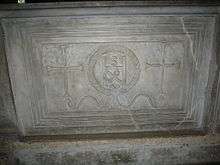Pope John II
Pope John II (Latin: Ioannes II; died 8 May 535), born Mercurius, was the bishop of Rome from 2 January 533 to his death.
Pope John II | |
|---|---|
| Papacy began | 2 January 533 |
| Papacy ended | 8 May 535 |
| Predecessor | Boniface II |
| Successor | Agapetus I |
| Personal details | |
| Birth name | Mercurius |
| Born | Rome |
| Died | 8 May 535 Rome |
| Buried | St. Peter's Basilica |
| Other popes named John | |
Early life

Mercurius was born in Rome, son of Praeiectus. He became a priest at St. Clement's Basilica on the Caelian Hill. The basilica still retains memorials of "Johannes surnamed Mercurius". A reference to "Presbyter Mercurius" is found on a fragment of an ancient ciborium. Several marble slabs that enclose the schola cantorum bear upon them, in the style of the sixth century, his monogram.[1]
Pontificate
Mercurius was elected pope on 2 January 533, becoming the first to adopt a new name upon elevation to the papacy.[1] Considering his birth name—after the pagan god Mercury—to be inappropriate, he took John as his papal name after Pope John I, who was venerated as a martyr.
Simony
At this period, simony (the purchase or sale of church offices or preferment) in the election of popes and bishops was rife among clergy and laity. During the sede vacante of over two months, "shameless trafficking in sacred things was indulged in. Even sacred vessels were exposed for sale". The matter was brought before the Senate, and laid before the Arian Ostrogothic Court at Ravenna. The last decree (Senatus Consultum) that the Roman Senate is known to have issued, passed under Boniface II, was directed against simony in papal elections. The decree was confirmed by Athalaric, king of the Ostrogoths. He ordered it to be engraved on marble and to be placed in the atrium of St. Peter's Basilica in 533.[1]
By one of Athalaric's additions to the decree, it was decided that if a disputed election was carried before the Gothic officials of Ravenna by the Roman clergy and people, three thousand solidi would have to be paid into court. This sum was to be given to the poor. John remained on good terms with Athalaric, who, being an Arian Christian, was content to refer to John's tribunal all actions brought against the Roman clergy. Cassiodorus, as praefectus praetorio under the Ostrogothic supremacy, entrusted the care of temporal affairs to Pope John II.[1]
The Liber Pontificalis records that the following year John obtained valuable gifts as well as a profession of orthodox faith from the Byzantine emperor Justinian I,[1] a significant accomplishment in light of the strength of Monophysitism in the Byzantine Empire at that time.
The notoriously adulterous behavior of Bishop Contumeliosus of Riez caused John to order the bishops of Gaul to confine him in a monastery.[2][3] Until a new bishop could be appointed, he bade the clergy of Riez to obey the Bishop of Arles.[1]
Arianism
In 535, two hundred and seventeen bishops assembled in a council at Carthage submitted to John II a decision about whether bishops who had lapsed into Arianism should, on repentance, keep their rank or be admitted only to lay communion. The question of re-admittance to the lapsed troubled north Africa for centuries (see Novatianism and Donatism). The answer to their question was given by Agapetus I, as John II died on 8 May 535. He was buried in St Peter's Basilica.[1]
See also
References
-

- De Jong, Mayke. "Transformations of Penance", Rituals of Power, (Frans Theuws and Janet Laughland Nelson, eds.) BRILL, 2000, p. 202 ISBN 9789004109025
-

| Catholic Church titles | ||
|---|---|---|
| Preceded by Boniface II |
Pope 533–535 |
Succeeded by Agapetus I |